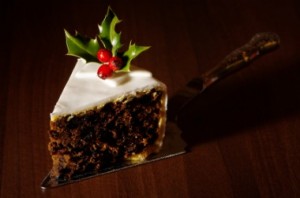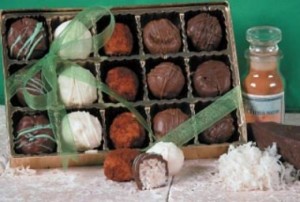
A great finish to your Christmas meal.
When it comes to Christmas meals, every family has traditions. For some, it’s a repeat of Thanksgiving: turkey, stuffing, cranberry sauce and green bean casserole. in other families, ham, rack of lamb, roast beef or even pasta takes center stage.
Here’s another tradition you might want to try: Celebrate an Irish Christmas.
Once upon a time, a traditional Irish dinner would have started with smoked fish, and moved on to roast goose with a potato stuffing, and maybe baked or boiled ham, says Margaret M. Johnson, celebrated author of “Tea & Crumpets,” an afternoon tea cookbook, and the forthcoming (September 2011) “Flavors of Ireland: Celebrating Grand Places and Glorious Food”. These days, she says, the Irish do celebrate more American-style: turkey with all the trimmings, cranberry sauce and all the rest.
But there are differences. Stuffing might be apple and black pudding, for example, or prepared with apricot, she says. “Tart ingredients are often mixed with bread and spices to counter the flavors of the poultry,” she says.
Of course, there’s no end to the ways the Irish can prepare spuds. Champ (mashed potatoes with scallions or chives) might find their way to the table, or colcannon (mashed potatoes with kale or cabbage). “You might also find garlic mash, fondant potatoes, or potato gratins with local Irish cheeses,” Johnson says.
Desserts might be a bit different, too. “Christmas cake and pudding are almost always included in the Christmas menu,” she says. “The cake is a traditional fruitcake where the fruit begins to ‘mature’ in whiskey for at least a month or more; Christmas pudding is a ‘steamed’ pudding, with the fruit ‘plumped up’ with Guinness or whiskey and served with brandy butter (hard sauce), and mince pie–originally dried fruit mixed with suet, but now maded with jarred mincemeat.”
Want to try your hand at replicating Irish Christmas traditions? Try these dessert recipes by Margaret Johnson. File one of these–Christmas Cake–away for next year. It takes several weeks. But two other desserts can be made with far less preparation. Here they are in her own words:
Traditionally, the biggest and most important festival in the Christian calendar is Christmas, and nowhere is it greeted with more enthusiasm than in Ireland. The spiritual preparation begins with Advent, but the practical preparation begins as early as late October when Christmas cakes, puddings, and mincemeat start to be made and readied for the season.
A well-known chronicler of tales of rural Ireland, Alice Taylor says that Christmas was the highlight of the year—“a time of great expectations which climaxed with Christmas Eve and Christmas Day, and then the Wren Day (December 26) brought a burst of color and music into the quiet countryside.” In her book The Night Before Christmas, she says, “The thought of the variety that Christmas would bring filled us with great anticipation. Lemonade, sweet cake, and chocolates in our home at that time were like manna in the desert.”
These three Christmas treats are the most popular. (Recipes from Margaret M. Johnson’s Puddings, Tarts, Crumbles and Fools, Chronicle Books, 2004)
Irish Whiskey Christmas Cake
This is the “Great Irish Cake,” the traditional pièce de résistance into which every Irish cook sinks her reputation. Spiced, sweet desserts like this cake have been a part of Irish holiday celebrations for centuries and were highly prized because they included spices and dried fruits that were once difficult and expensive to obtain.
The traditional topping for the cake is a layer of almond paste and Royal Icing.
2 cups dried currants
2 cups golden raisins
1 cup dark raisins
2 ounces candied cherries
2 ounces candied mixed citrus peel
Grated zest and juice of 1 lemon
2/3 cup chopped almonds
1 1/2 teaspoon mixed spice or pumpkin pie spice
1/2 teaspoon ground nutmeg
1 cup Irish whiskey
1 cup (8 ounces) Kerrygold Irish butter, at room temperature
1 cup soft brown sugar
5 large eggs
2 cup all-purpose flour, sifted
1 egg white, beaten until frothy, for brushing
One 7-ounce package almond paste, such as Odense brand
Royal Icing
2 large egg whites
4 cups confectioners’ sugar
2 tablespoons fresh lemon juice
Holly sprigs for decoration (optional)
The day before baking (and several weeks before serving), combine all the dried and candied fruit, peel, zest and juice, almonds, and spices in a large bowl with 1/2 cup of the whiskey. Cover and let stand at room temperature overnight.
Preheat the oven to 275° F. Butter a 9-inch round spring form pan and line the bottom with a round of parchment or waxed paper. In a large bowl, beat the butter and brown sugar with an electric mixer until light and fluffy. Add the eggs, one at a time, beating in each thoroughly and adding some of the flour with each egg. Fold in the remaining flour, and mix in the soaked fruit one half at a time. Pour the batter into the prepared pan. Bake for 2 to 2 1/2 hours, or until the top is firm to the touch and a skewer inserted into the center comes out clean.
Remove from the oven and let cool in the pan on a wire rack for 30 minutes. Prick the top of the cake with a skewer in several places and pour the remaining 1/2 cup whiskey over the top. Run a knife around the sides of the pan and release the sides. Invert the cake onto the rack to cool completely. Remove the lining paper and turn right side up. Wrap the cake in plastic wrap, then aluminum foil, and store in a cool, dark place to allow the cake to mature. Unwrap the cake every week and sprinkle a few tablespoons of Irish whiskey over the top.
On the day before serving, unwrap the cake and brush the top with the egg white. Shape almond paste into a flat disk and place between 2 sheets of wax paper. Roll out to a 9-inch circle and place on top of the cake. Cover with plastic wrap and refrigerate overnight.
To make the icing: In a large mixing bowl, combine the egg whites, confectioners’ sugar, and lemon juice. With an electric mixer, beat for 5 minutes, or until the mixture is stiff enough to spread. With a flexible rubber spatula, spread the icing over the top and sides of the cake. Decorate with sprigs of holly, if desired.
Serves 10 to 12
Guinness Christmas Cake
1 cup (8 ounces) Kerrygold unsalted butter, cut into pieces
1 1/4 cups Guinness Stout
1 cup packed light brown sugar
3 1/2 cups mixed raisins and sultanas
4 ounces candied mixed citrus peel
4 cups self-rising flour
2 teaspoons mixed spice or pumpkin pie spice
4 ounces candied cherries
3 large eggs, beaten
Preheat the oven to 325° F. Line an 8-inch square cake pan with a double thickness of waxed paper. In a medium saucepan over medium heat, combine the butter, sugar, Guinness, raisins, sultanas, and citrus peel. Bring gently to a boil and cook, stirring frequently, for 3 to 4 minutes, or until slightly thickened. Remove from the heat and let cool for 10 to 15 minutes.
In a medium bowl, sift together the flour and spice. Stir in the raisin and stout mixture and the cherries. Add the eggs and stir until well blended. Spoon into the prepared pan and smooth the top. Bake on the middle shelf of the oven for 60 to 70 minutes, or until a skewer inserted into the center comes out clean. Remove from the oven and let cool on a wire rack for 30 minutes. Invert the cake onto the rack to cool completely. Remove the lining paper and turn the cake right side up. If not serving immediately, wrap the cake in plastic wrap, then aluminum foil, and store in a cool, dark place for several weeks to allow the cake to mature.
Serves 8 to 10
Christmas Pudding
Often called “plum pudding” — despite the fact that it contains no plums whatsoever — this steamed or boiled pudding was first recorded as “Christmas Pudding” in 1858 in a novel by British author Anthony Trollope. The name is probably derived from the substitution of raisins for dried plums as an ingredient in pies during medieval times. In the 16th and 17th centuries, dishes made with raisins retained the term “plum,” and in the Victorian era, Christmas plum puddings became a well-loved dessert. Curiously, plum pudding was a latecomer to Ireland, but it caught on quickly and today it’s one of the most traditional of all Christmas dishes. Not to be confused with fruitcake, it’s actually more like a dense spice cake and is delicious served warm with Brandy Hard Sauce.
3/4 cup dark raisins
1/2 cup golden raisins
1/3 cup candied cherries, halved
1/3 cup chopped candied pineapple
1/2 cup brandy or dark rum
1 1/4 cups all-purpose flour
3/4 teaspoon baking powder
1 teaspoon grated orange zest
1 teaspoon ground cinnamon
1/2 teaspoon ground ginger
1/8 teaspoon ground cloves
1/2 cup packed light brown sugar
4 tablespoons unsalted Kerrygold Irish butter at room temperature
4 large egg whites
1/3 cup pecan halves
2 tablespoons Irish whiskey
Combine the raisins and candied fruit in a glass jar or bowl. Add the brandy, cover, and let stand at room temperature for 3 days. Butter a 6-cup pudding mold or deep, heatproof casserole dish. In a medium bowl, combine the flour, baking powder, orange rind, cinnamon, ginger, and cloves.
In a large bowl, beat the brown sugar and butter with an electric mixer until light and fluffy. Add the egg whites and beat well. With a wooden spoon, stir in half of the flour mixture, then half of the fruit mixture. Repeat, stirring in the remaining flour and remaining fruit. Stir in the pecans. Spoon the batter into the prepared mold, cover with parchment or waxed paper, then cover tightly with foil. Tie the foil in place with kitchen twine.
Place the mold in a stockpot or Dutch oven fitted with a rack, or place a folded kitchen towel on the bottom of the pot to prevent direct contact with the bottom of the pot. Add enough hot water to the pot to come halfway up the sides of the mold or casserole dish. Cover and steam on medium-low heat for 2 to 2 1/2 hours, or until a skewer inserted into the center comes out clean. (Check the water level once or twice during cooking and add more water when necessary.)
Carefully remove the pudding mold from the pot. Remove the foil and parchment, and run a metal spatula around the sides to loosen. Place a serving plate over the mold and invert. Drizzle the whiskey over the top. Slice and serve warm. (If not serving immediately, let the pudding cool, covered, in the mold. When completely cool, unmold, wrap in plastic wrap, then aluminum foil. Refrigerate the pudding for up to 1 week or freeze. To serve, put the pudding back into its mold, cover with waxed paper or foil, and steam for 1 hour, as above, or until heated through. Thaw frozen pudding before reheating as above.)
Serves 10 to 12
Brandy Hard Sauce
1/2 cup (4 ounces) unsalted Kerrygold Irish butter at room temperature
1 1/2 cups confectioners’ sugar, sifted
2 tablespoons brandy
In a small bowl, beat the butter and sugar together with an electric mixer until light and fluffy. Add the brandy and beat until smooth. Transfer to a small bowl or crock, cover, and refrigerate for up to 2 days Return to room temperature before serving.
Makes 3/4 cup







